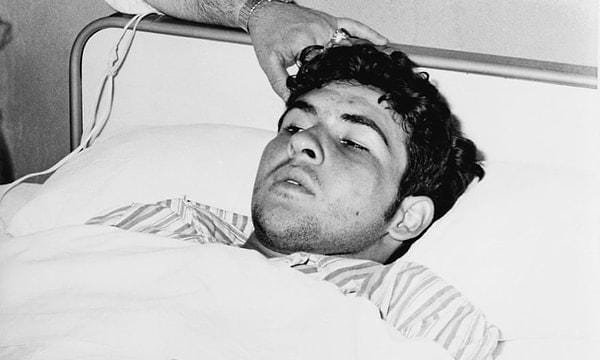The story of Keith Sapsford is one of the most heart-wrenching and tragic incidents in aviation history. Keith Sapsford was a 14-year-old boy who, in his attempt to explore the world, tragically fell to his death from a plane’s wheel well in 1970. His death became a well-known story, not only because of its tragedy but also because of the haunting photograph captured just before the fall. This blog will explore Keith’s background, the events leading up to the incident, and the aftermath that left the world in shock.
Who Was Keith Sapsford?
Keith Sapsford was born in Australia in 1956 to parents who loved him dearly. Like many young boys, Keith had a sense of adventure and an overwhelming curiosity about the world. However, his need for exploration went beyond what his parents could provide. He wanted to travel, to experience different countries and cultures, but his family’s financial situation and circumstances couldn’t offer him that opportunity.
Unfortunately, that adventurous spirit took a tragic turn when Keith made a dangerous decision that would ultimately lead to his death. As he grew older, his longing to see the world grew stronger, leading him to a fateful day in February 1970.
The Fateful Day of Keith Sapsford’s Death
On February 21, 1970, Keith Sapsford made a decision that would change his life forever. He ran away from his home in Randwick, Sydney, and made his way to Sydney Airport. His plan was simple but incredibly dangerous: to stow away on an international flight by hiding in the wheel well of a plane.
Keith managed to sneak past security and found his way into the wheel well of a Japan Airlines flight bound for Tokyo. However, the decision to hide in the plane’s undercarriage was far more perilous than he likely realized. The wheel well of an aircraft is not designed for human survival. It’s cramped, unpressurized, and subjected to freezing temperatures during flight. But Keith, driven by his sense of adventure and a desire to see the world, went ahead with his plan.
The Moment of Tragedy
As the Japan Airlines flight took off, Keith Sapsford’s fate was sealed. The plane climbed higher and higher, and as the landing gear retracted, the wheel well doors opened. Tragically, Keith fell from the plane, plummeting 200 feet to the ground below. A tragic twist to this story is that a photographer, John Gilpin, was testing his new camera at the time and accidentally captured the exact moment Keith fell from the plane.
The photograph, which shows Keith Sapsford tumbling through the air, became an iconic image, symbolizing both the tragic loss of life and the dangers of attempting such a dangerous act. This moment shocked the world and served as a sobering reminder of the risks associated with stowing away on aircraft.
Why Did Keith Sapsford Stow Away?
The question on everyone’s mind is: why would a 14-year-old boy take such a dangerous risk? Keith Sapsford’s desire to explore the world may have stemmed from his dissatisfaction with his life in Australia. According to reports, Keith had recently returned from a Catholic institution for troubled boys, and it’s believed that he may have been struggling with feelings of confinement or a desire for freedom.
His father, an academic, mentioned in interviews that Keith had always been fascinated by the idea of travel and adventure. He longed to see distant places, and the airport was the perfect place for him to dream about those journeys. Sadly, that dream ended in disaster.
The Dangers of Stowaways in Aircraft
Keith Sapsford’s tragic story sheds light on a broader issue: the dangers of stowing away in the wheel wells of airplanes. Many people who attempt this act underestimate the life-threatening conditions they face. The wheel wells are not pressurized, which means that as the plane climbs to cruising altitude, oxygen levels drop significantly. This can lead to hypoxia, a condition where the brain and body are deprived of oxygen, causing unconsciousness and death.
In addition to the lack of oxygen, the temperatures in the wheel wells can drop to as low as -50°C (-58°F) during flight, making it nearly impossible for a human being to survive for more than a few minutes. Furthermore, when the landing gear is retracted, there’s very little space for movement, increasing the risk of being crushed.
Aftermath and Legacy of Keith Sapsford’s Death
Keith Sapsford’s death had a profound impact on both his family and the world. His tragic story became a cautionary tale for anyone thinking of attempting a similar act. Airports and airlines around the world tightened security measures to prevent such incidents from happening again.
Though his death was devastating, it also brought awareness to the dangers of stowing away, helping to prevent future tragedies. The photograph of Keith Sapsford’s fall became a haunting reminder of the perils of desperation and the consequences of risky decisions.
Lessons Learned from the Story of Keith Sapsford
Keith Sapsford’s story serves as a tragic lesson for those who may feel trapped or overwhelmed by their circumstances. His desire to escape his life and explore the world led him to make a dangerous and ultimately fatal decision. It’s important to remember that no matter how difficult life may seem, there are always safer, healthier alternatives to dangerous risks.
This story also emphasizes the need for better communication and support for young people who feel lost or trapped. Keith’s death could have been prevented if he had the right guidance and support at the time.
Read more: Bruce Wilpon Wife: A Glimpse Into the Private Life of the Wilpon Family
FAQs About Keith Sapsford
Keith Sapsford was a 14-year-old Australian boy who tragically died in 1970 after falling from the wheel well of a Japan Airlines flight.
Keith had a strong desire to travel and see the world. He likely stowed away in an attempt to experience the freedom of exploration, but tragically underestimated the dangers of hiding in a plane’s wheel well.
Keith Sapsford fell from the wheel well of a Japan Airlines plane shortly after takeoff. The landing gear retracted, and he fell 200 feet to his death.
It does not appear that anyone knew of Keith’s plan to stow away on the plane. He managed to sneak into the wheel well unnoticed.
John Gilpin, the photographer, was testing out his new camera at Sydney Airport when he accidentally captured the tragic moment of Keith’s fall. The photograph became famous and is often associated with the incident.
Conclusion
The story of Keith Sapsford is both tragic and cautionary. His decision to seek adventure in such a dangerous way cost him his life. Through his story, we are reminded of the importance of finding safe ways to explore the world and the necessity of supporting young people who may feel trapped or lost. While his death is a heartbreaking reminder of the risks of stowing away, it also serves as a valuable lesson about the consequences of taking extreme risks.





